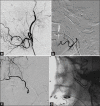Facial necrosis after endovascular Onyx-18 embolization for epistaxis
- PMID: 23956938
- PMCID: PMC3740618
- DOI: 10.4103/2152-7806.115388
Facial necrosis after endovascular Onyx-18 embolization for epistaxis
Abstract
Background: Evolution in techniques and equipment has expanded the role, effectiveness, and safety of endovascular transarterial embolization for the treatment of severe epistaxis. Risks from this treatment approach include major ischemic complications. To date, there have been only a few reports of soft tissue necrosis following endovascular embolization for severe epistaxis; none involve the use of Onyx-18.
Case description: We report the case of a 52-year-old woman who presented with epistaxis that was refractory to medical and surgical management, which lead to endovascular intervention and embolization with Onyx-18. The patient subsequently developed nasal ala and facial necrosis as a result of the procedure.
Conclusion: We report the use of Onyx-18 for the endovascular embolization of a patient with severe epistaxis and subsequent complications. In cases of severe epistaxis that warrant intervention in the form of embolization, ischemic complications are rare; however, ischemic complications may be unavoidable and should factor into the discussion regarding procedural risks.
Keywords: Endovascular embolization; Onyx; epistaxis; soft tissue necrosis.
Figures



Similar articles
-
Superselective microcoil embolization in severe intractable epistaxis: an analysis of 12 consecutive cases from an otorhinolaryngologic and an interventional neuroradiologic point of view.Eur Arch Otorhinolaryngol. 2015 Nov;272(11):3317-26. doi: 10.1007/s00405-014-3427-2. Epub 2014 Dec 11. Eur Arch Otorhinolaryngol. 2015. PMID: 25502741
-
Ear necrosis resulting from the endovascular onyx-18 embolization of a dural arteriovenous fistula fed by the posterior auricular artery.J Neuroimaging. 2009 Jul;19(3):259-62. doi: 10.1111/j.1552-6569.2008.00291.x. Epub 2008 Nov 3. J Neuroimaging. 2009. PMID: 19021839
-
Complications and Outcomes of Endovascular Embolization for Intractable Epistaxis: A Systematic Review and Meta-analysis.Ann Otol Rhinol Laryngol. 2023 Oct;132(10):1233-1248. doi: 10.1177/00034894221143187. Epub 2022 Dec 29. Ann Otol Rhinol Laryngol. 2023. PMID: 36582148
-
Transarterial embolization of intractable nasal and oropharyngeal hemorrhage using liquid embolic agents.J Neurointerv Surg. 2015 Jul;7(7):537-41. doi: 10.1136/neurintsurg-2014-011101. Epub 2014 May 26. J Neurointerv Surg. 2015. PMID: 24862104
-
Long-term follow-up of transarterial balloon-assisted Onyx embolization for endovascular treatment of dural arteriovenous fistulas: A single-institution case series and literature review.Clin Neurol Neurosurg. 2020 Dec;199:106256. doi: 10.1016/j.clineuro.2020.106256. Epub 2020 Oct 1. Clin Neurol Neurosurg. 2020. PMID: 33069089 Review.
Cited by
-
Posterior short ciliary arteries ischemia following embolization of anterior ethmoid artery to treat dural arteriovenous fistulas: a case report.BMC Ophthalmol. 2024 Oct 22;24(1):465. doi: 10.1186/s12886-024-03725-x. BMC Ophthalmol. 2024. PMID: 39438805 Free PMC article.
-
Outcomes after endovascular embolization for the treatment of nasal and oropharyngeal hemorrhage: safety, efficacy, and rebleeding.Neuroradiol J. 2022 Jun;35(3):329-336. doi: 10.1177/19714009211042893. Epub 2021 Sep 3. Neuroradiol J. 2022. PMID: 34477042 Free PMC article.
-
Intractable epistaxis: which arteries are responsible? An angiographic study.Surg Radiol Anat. 2017 Nov;39(11):1203-1207. doi: 10.1007/s00276-017-1856-5. Epub 2017 May 16. Surg Radiol Anat. 2017. PMID: 28508924
References
-
- Andersen PJ, Kjeldsen AD, Nepper-Rasmussen J. Selective embolization in the treatment of intractable epistaxis. Acta Otolaryngol. 2005;125:293–7. - PubMed
-
- Leppanen M, Seppanen S, Laranne J, Kuoppala K. Microcatheter embolization of intractable idiopathic epistaxis. Cardiovasc Intervent Radiol. 1999;22:499–503. - PubMed
-
- Metson R, Hanson DG. Bilateral facial nerve paralysis following arterial embolization for epistaxis. Otolaryngol Head Neck Surg. 1983;91:299–303. - PubMed
-
- Ntomouchtsis A, Venetis G, Zouloumis L, Lazaridis N. Ischemic necrosis of nose and palate after embolization for epistaxis.A case report. Oral Maxillofac Surg. 2010;14:123–7. - PubMed
Publication types
LinkOut - more resources
Full Text Sources
Other Literature Sources

